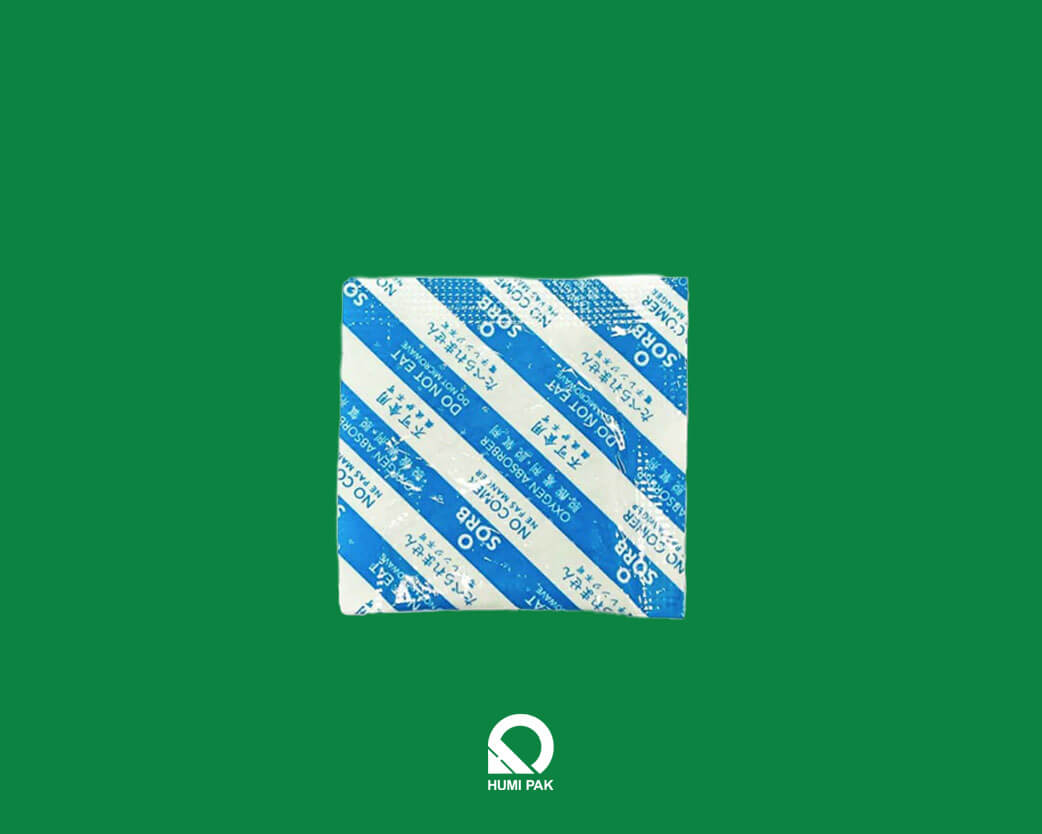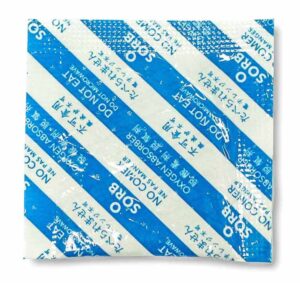All About Oxygen Absorber Sachet - O Sorb

Oxygen absorbers are essential tools in packaging, designed specifically to remove oxygen from sealed containers. Their primary function is to extend the shelf life of perishable goods, especially food items, by preventing aerobic pathogens’ oxidative degradation and growth.
Freshness and extended shelf life are important, and the role of oxygen absorbers has become increasingly crucial in various industries. This article will share the components and their interaction for optimizing the use of oxygen absorbers and ensuring products remain fresh and free from spoilage for extended periods.
How Oxygen Absorbers Work
Oxygen absorbers function based on a chemical reaction. The primary active ingredient in many of these absorbers is iron powder. When exposed to oxygen, the iron oxidizes, transforming into iron oxide.
This process actively pulls oxygen from the surrounding environment and traps it. Removing the oxygen from a sealed container significantly reduces the oxidation rate for the contained products, thereby prolonging shelf life and preventing spoilage.
Key Components:
- Iron Powder: The primary reactant responsible for oxygen absorption.
- Salt: Often acts as a catalyst, accelerating the reaction between the iron and oxygen.
- Activated Carbon: While not present in all oxygen absorbers, it can help absorb other gases and odours.
- Moisture: A minimal moisture is necessary to initiate the iron’s reaction with oxygen.
- Outer Packaging Material: Typically made from a material that allows the transfer of gases (like oxygen) but keeps the iron and other components sealed.
Benefits and Advantages
Oxygen absorbers play a crucial role in modern packaging, offering tangible benefits that enhance product quality, extend shelf life, and lead to notable cost savings.
Extended Shelf Life of Perishable Products: Extending the shelf life of perishables is a primary benefit of these absorbers. Removing oxygen from sealed containers reduces the oxidation process, enabling products to be stored longer without quality degradation. This is advantageous for manufacturers and retailers, as it broadens distribution opportunities and minimizes the pressure of immediate sales.
Maintaining Food Quality: Oxygen interaction can compromise foods’ taste, colour, and texture. The original flavours are preserved by reducing oxygen exposure, preventing unsightly discolouration. Furthermore, the texture of items, whether preventing them from becoming too dry or retaining unwanted moisture, is better maintained, ensuring a consistent consumer experience.
Prevention of Microbial Growth: Reducing oxygen levels in packaging inhibits the growth of harmful microorganisms like aerobic bacteria, mould, and mildew. These microorganisms can degrade product quality and pose health concerns. Using these absorbers ensures products stay uncontaminated, reinforcing trust in their safety.
Cost Benefits: Financially, incorporating these absorbers in packaging can lead to savings. They reduce product spoilage, meaning less wastage for manufacturers and retailers. The extended shelf life also means less frequent stock replenishments, translating to fewer shipments and associated costs.
Types and Application
Oxygen absorbers come in various types, each tailored to suit specific needs based on their absorption capacity and the intended product type. Understanding these varieties ensures optimal product preservation and avoids unnecessary costs or inefficiencies.
Varieties Based on Absorption Capacity:
- Low-Capacity Absorbers: These are designed to absorb smaller amounts of oxygen, typically suitable for smaller product packaging. They often range from 20cc to 100cc in capacity.
- Medium-Capacity Absorbers: Falling within the range of 100cc to 500cc, these absorbers are ideal for mid-sized packaging needs, striking a balance between performance and cost.
- High-Capacity Absorbers: With capacities exceeding 500cc, these are tailored for larger product containers or bulk storage. Their robust design ensures they handle substantial amounts of oxygen, maintaining product integrity over extended durations.
Appropriate Use for Different Product Types:
- Food Products: Different absorption capacities may be needed depending on the specific food type. For instance, dry foods like nuts or grains might require lower capacity absorbers, while moist foods, prone to quicker spoilage, might benefit from higher capacity ones.
- Pharmaceuticals: Medications and vitamins, sensitive to oxygen degradation, often require precise oxygen level control. Medium to high-capacity absorbers are generally preferred to ensure product potency and shelf life.
- Electronics: While not perishable in the traditional sense, certain electronic components can be affected by oxygen over time. Low to medium-capacity absorbers are often adequate for most electronic packaging needs.
- Artefacts and Documents: Historical artefacts and important documents can degrade due to oxygen exposure. Depending on the size and significance, a range of absorber capacities might be employed to ensure preservation.
Choosing the Right Absorber for Specific Needs
The decision-making process involves understanding two primary facets: estimating the appropriate size and quantity and considering the specific product type and desired shelf life. By addressing these aspects, informed decisions that best serve preservation needs can be made.
Estimating the Right Size and Quantity:
- Volume of the Package: Begin by calculating the volume of the container or package. The larger the volume, the more oxygen it can hold, dictating a higher capacity absorber.
- Residual Oxygen: After sealing, some amount of oxygen remains trapped. Estimating this residual oxygen volume can then determine the absorber size required.
- Multiple Small vs. Single Large Absorber: In certain scenarios, using multiple smaller absorbers can be more effective than a single large one. This distribution can ensure more even oxygen absorption, especially in irregularly shaped packages.
- Safety Margin: Always opt for a slightly higher capacity than calculations suggest. This safety margin ensures that unexpected spikes in oxygen levels are effectively managed, guaranteeing optimal product preservation.
Considerations Based on Product Type and Desired Shelf Life:
- Nature of the Product: Perishable goods, like certain foods, demand a rigorous approach, often requiring high-capacity absorbers. Conversely, products less sensitive to oxygen might fare well with lower-capacity options.
- Desired Shelf Life: The longer the intended storage period for a product, the more crucial oxygen removal becomes. If aiming for extended shelf life, leaning towards higher capacity absorbers is prudent.
- Sensitivity to Oxygen: Some products deteriorate rapidly with even minimal oxygen exposure. For such items, it’s crucial to prioritize high-efficiency absorbers that act swiftly and maintain low oxygen levels consistently.
- Storage Conditions: Environmental factors like temperature and humidity can influence the oxidation rate. Recognizing these conditions can help tailor the choice of absorber to the specific storage environment.
Safety Considerations
Oxygen absorbers present a generally safe profile; prudence demands appropriate handling and storage practices. Ensuring guidelines are followed allows their benefits to be reaped without compromising safety.
Are Oxygen Absorbers Toxic?
Oxygen absorbers predominantly consist of iron powder. Upon exposure to oxygen, this iron undergoes oxidation, a process very similar to the common rusting of iron in our daily environment. This rust formation is harmless and categorically non-toxic. However, it’s essential to distinguish between something being non-toxic and being fit for consumption.
While the substances within the absorbers aren’t classified as toxic, they are not intended for ingestion. If an absorber packet is accidentally consumed, it typically doesn’t lead to serious health ramifications but might cause minor digestive discomfort. For safety and clarity, manufacturers commonly label these packets with the directive “Do Not Eat,” ensuring users are wary of potential ingestion risks.
Safe Handling and Storage:
Safety, particularly in households with children and pets, is paramount. Despite their non-toxic components, the small packets should be stored out of reach to prevent accidental ingestion. Children’s curiosity and pets’ propensity to chew on foreign objects make this a necessary precaution. If a packet is opened and not all the absorbers are used immediately, sealing the remaining ones in an airtight container is crucial.
Their designed function means they start absorbing oxygen when exposed to it. Thus, sealing them ensures they remain effective for future use. While handling, although they aren’t hazardous, it’s advisable to use gloves, especially if contact is prolonged or involves significant quantities.
This prevents any minor skin irritations that some individuals might experience. Placing them in a cool, dry, and sun-protected environment ensures their efficacy for long-term storage. When their purpose has been served, disposal is straightforward. Given their primarily iron composition, they can be discarded with regular waste, breaking down over time.
Conclusion
Oxygen absorbers have proven to be an effective tool in the packaging industry, addressing the critical need for product preservation. Their ability to maintain low oxygen levels in sealed packages helps prolong shelf life and maintain product quality.
Understanding oxygen absorbers’ correct use and safety becomes essential as the demand for longer shelf life and better product integrity grows. Humi Pak utilizes advanced Japanese material technology to manufacture food-grade oxygen absorbers. Feel free to contact us to learn more about oxygen absorbers.


